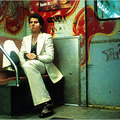PHILADELPHIA
IN a vast dining room on the edge of Center City here, children squirm at tables where families of four or five have come to eat. Young couples clamor for perches at a counter facing a pizza oven, then graze their way through salads, sausage and gelato. The ceiling is high, the platoon of servers large, the decibel count formidable. It’s a typical night at Osteria.
Not far away at Vetri, the clink of silverware can be heard during lulls in conversation. One of only a few attendants lifts a whole branzino high in the air, inviting adoration of its glittering salt robe, then spirits it back to the kitchen so it can be anointed with a white truffle sauce. That’s a journey of just a few paces through a narrow town house that could be mistaken for somebody’s home, at least if that somebody was capable of a prosciutto-stuffed guinea hen as sumptuous as the one here. When hushed diners bite into it, their eyes glaze with pleasure.
There’s a lot the restaurants Osteria and Vetri don’t have in common. There’s one very lucky thing they do. Both are helmed by Marc Vetri, whose enormous talents have brought him a widespread, fervent regard he has never really exploited. And with the opening of Osteria in February, he has taken a huge step. He has bucked his obsessive, controlling nature and accepted what is apparently nearly every acclaimed contemporary chef’s fate: to multitask across multiple stages.
It’s a move he resisted for years, and it’s fraught with suspense. Can he replicate Vetri’s magic at Osteria? Can he preserve it at Vetri? I recently visited both restaurants to try to get a sense of that.
Vetri has been open since 1998, and its exposure and Mr. Vetri’s renown have always been limited somewhat by its humble size — it has only about 35 seats — and his reluctance to stray far beyond it. Time and again Philadelphia developers would approach him and his business partner, Jeff Benjamin, who owns Vetri and Osteria with him, about doing a second restaurant as part of one urban project or another.
He would say no.
Atlantic City would come calling, beckoning him toward the beach, where two of Philadelphia’s other most celebrated cooks, Georges Perrier and Susanna Foo, had planted umbrellas.
He would say no.
He didn’t want partners other than Mr. Benjamin, because he wasn’t sure he could trust partners other than Mr. Benjamin. He didn’t need a fresh challenge, because he wasn’t restless.
“I just loved my work,” Mr. Vetri, 40, told me when I called him following my visits to Vetri and Osteria. “I loved my restaurant. I really got to be creative there, and I was loving that.”
“Not everybody,” he later added, “has the personality and the wherewithal to do television shows and other restaurants.”
So why the agreement, in early 2006, to construct Osteria, which is on the ground floor of a new lofts development in a gentrifying area of the city? For one thing, the deal he and Mr. Benjamin got let them do it without taking on investors, though they did max out several credit cards.
As Mr. Benjamin, 38, told me during a separate phone conversation, “It’s really nice that when we have our stockholders’ meeting, it’s the two of us over a cup of coffee.”
In addition, Mr. Vetri’s family life was changing. He and his wife were about to have their first child. Making more money seemed like a smart idea.
And then there was that twitch, faint but undeniable, when he watched professional acquaintances like Mario Batali do their television shows, build their empires.
“There’s the worry: maybe I’m missing the bandwagon,” Mr. Vetri said.
Osteria is much different from Vetri. It has a red concrete floor and 65 seats, not counting about a dozen bar stools and a large private dining room in back. The average entree at Vetri is about $36. At Osteria it’s about $26, and the menu’s focus is really elsewhere: on the pizzas, starters, pasta dishes, sides.
It fits a familiar pattern: chef with refined restaurant lavishes his or her talents on a more affordable, easygoing offspring. Osteria is to Vetri as Craftbar is to Craft.
But Mr. Vetri said it’s not a product of a carefully plotted strategy. It’s the answer to a long-held desire to open a casual restaurant, much like the ones he admires in Italy, where a diner can grab a plate of arugula or a bowl of bucatini without any ceremony.
Despite the differences between Osteria and Vetri, they clearly spring from the same source: a chef entranced with cured meats and organ meats and meats that aren’t ubiquitous like wild boar, rabbit and goat.
Vetri is where you find the goat. It’s spit-roasted over oak in the parking lot out back before it’s finished in the oven inside, and it emerges from the process in such crunchy, fatty and tender form that I could make a case for goat’s being the new duck, or duck on testosterone therapy. Mr. Vetri relishes big, brawny dishes.
And silken, oozing ones. Egg yolks pop up — and gush forth — frequently. There’s one on the “lombarda” pizza at Osteria; it mingles with cotechino (a sausage made in house from pork shoulder and fatback) and with mozzarella and bitto cheeses.
At Vetri there’s a yolk in the center of a delicate asparagus flan, and another in an ultrarich appetizer of chopped sautéed veal kidneys flavored with Cognac and paired with soft polenta. Mr. Vetri repeatedly brings soft polenta into play.
He uses freshly made noodles for virtually all the pasta dishes at both restaurants. And his orientation is more northern than southern Italian. That’s especially pronounced at Vetri, where the taste of butter comes through more often and more strongly than the taste of olive oil and where you could easily eat a meal or two without bumping into a tomato.
I liked Vetri (1312 Spruce Street, 215-732-3478 or vetriristorante.com) immensely; if it’s suffering from the birth of Osteria and the division of Mr. Vetri’s attention, I didn’t see the signs. Dining there two nights in a row, I couldn’t work my way through as much of the menu as I do when I review a New York restaurant and visit more frequently. But most of what I ate was wonderful, suggesting to me that Vetri ranks with the very best Italian restaurants in New York.
My favorite dishes achieved elegance without attitude, an attribute that’s not all that common. I think of those veal kidneys. And of that flan. And of that guinea hen, so incredibly tender, and stuffed with not only prosciutto but also foie gras and a mixture including ground thigh meat, innards, nutmeg and pistachio. And of ravioli filled with sweetbread and served in a braised veal sauce. There’s something opulently French about Mr. Vetri’s Italian, and Vetri’s wine list tracks with that, presenting selections from both countries.
The restaurant’s setting on the main floor of a town house gives it an irresistible coziness and intimacy, and it’s filled with amusing touches: a shelf of playfully shaped decanters; green and gold chessboard ceilings in the bathrooms, where the walls behind the sinks are covered with broken sections of ceramic plates.
The one discordant note during dinner at Vetri was the service. No particular server takes charge of your table or of the front door; everybody is supposed to pitch in. And restaurants turn out to be like presidential administrations: if no one is forced to take ultimate responsibility, no one will. For short stretches, my companions and I felt abandoned.
Osteria was an even rockier experience, and a less impressive one, illustrating some of the perils facing restaurateurs who tackle an entirely new kind of venture. Mr. Benjamin and Mr. Vetri have had to field a larger team of greener servers, some of whom struggled to talk accurately about the menu.
They have miscalculated in some ways. The long counter facing the pizza oven and other cooking equipment is too tall for the stools, which are scrunched too close together, and a panel on the far side of the counter rises too high to permit a clear glimpse of what cooks are doing, seemingly negating the whole point of the arrangement.
Pasta was overcooked in several underseasoned dishes I tried, including fusilli with fava beans, pecorino and mint, and bucatini with a testa (pig’s head) ragù. And an excess of vinegary dressing obscured the pleasures of folds of beef that had been cured for a full month in a mixture including juniper berries, sage, rosemary and peppercorns. Almost all of the cured meats Mr. Vetri serves at Osteria and Vetri are made in house.
So is his porchetta, thinly sliced pork loin and belly that is at once ethereally textured and deeply flavored. He uses the slices in a porchetta tonnato and on a porchetta pizza, which also has fennel and mozzarella. It’s great, and Mr. Vetri flouts the current culinary rage by doing Roman-style crusts, which are thinner and crunchier than Neapolitan ones.
The oak-burning stone oven in which they’re baked is used for other dishes as well. It was the source of a smoky, succulent pressed chicken entree, which came with a gratin of escarole and Parmesan that was just the sort of gooey, rich, salty concoction Mr. Vetri does so well.
Osteria (640 North Broad Street, 215-763-0920 or osteriaphilly.com) had its charms, including a tender appetizer of grilled octopus; a rib-eye with just the right char; a Nutella pizza, dusted with powdered sugar, that didn’t taste nearly as hokey as it sounds; an affordably priced, almost entirely Italian wine list; and a sommelier, Karina Lyons, who’s as personable and contagiously enthusiastic a guide as any diner could wish for. Even when I was disappointed with my food, I was having a good time.
And I was confident Mr. Vetri would whip things into better shape. I could see him darting around, his face a study in unalloyed concentration, as he alternately said his obligatory hellos to regulars and looked over the shoulders of kitchen workers, tasting and tweaking what they were doing.
He apparently spends half of every night at Vetri, half at Osteria, because he can’t just let either of them be. That would be hazardous. That would also be some other chef.






